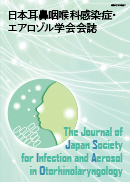Volume 7, Issue 3
Displaying 1-6 of 6 articles from this issue
- |<
- <
- 1
- >
- >|
Original Article
-
2019 Volume 7 Issue 3 Pages 107-110
Published: September 20, 2019
Released on J-STAGE: September 20, 2019
Download PDF (617K)
Review
-
2019 Volume 7 Issue 3 Pages 111-115
Published: September 20, 2019
Released on J-STAGE: September 20, 2019
Download PDF (1811K)
Original Article
-
2019 Volume 7 Issue 3 Pages 116-120
Published: September 20, 2019
Released on J-STAGE: September 20, 2019
Download PDF (993K)
Case Reports
-
2019 Volume 7 Issue 3 Pages 121-125
Published: September 20, 2019
Released on J-STAGE: September 20, 2019
Download PDF (12370K) -
2019 Volume 7 Issue 3 Pages 126-129
Published: September 20, 2019
Released on J-STAGE: September 20, 2019
Download PDF (5049K) -
2019 Volume 7 Issue 3 Pages 130-133
Published: September 20, 2019
Released on J-STAGE: September 20, 2019
Download PDF (4307K)
- |<
- <
- 1
- >
- >|
